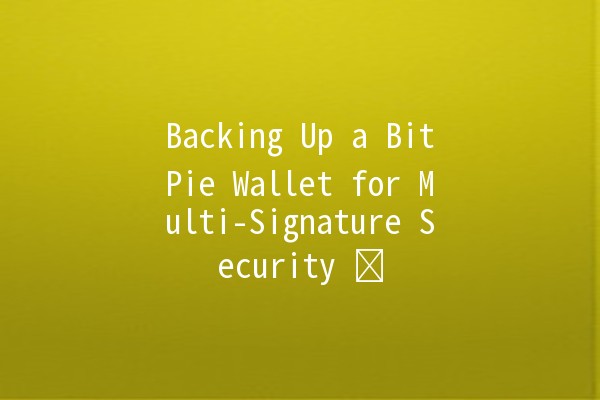
In the world of cryptocurrency, security is paramount. The BitPie wallet has gained popularity among crypto enthusiasts for its userfriendly interface and robust security features. One of the key functionalities that users often overlook is the ability to back up a multisignature wallet. In this article, we will delve into the importance of backing up a BitPie multisignature wallet and provide practical tips and techniques to ensure your assets are wellprotected.
Understanding MultiSignature Wallets
Multisignature wallets, or multisig wallets, require multiple private keys to authorize a transaction. This method enhances security as it adds an extra layer of protection. For example, a 2of3 multisig wallet requires two out of three possible private keys to execute a transaction. This can be particularly useful for businesses or groups managing a shared crypto fund, as it prevents any single person from having complete control over the assets.
Why Backing Up is Essential
Any wallet can be vulnerable to loss or theft, and multisignature wallets are no exception. Failing to back up your wallet can lead to irreversible loss of assets. Without proper backup, if you lose access to your keys or your wallet becomes damaged, you may not be able to recover your funds. Therefore, having a reliable backup process is crucial.
One of the most effective ways to ensure the safety of your BitPie wallet is to establish a solid backup strategy. This involves a few crucial steps:
Backup Your Private Keys: The first step in backing up your multisignature wallet is to securely store your private keys. These keys are the only way to access your funds, and losing them can mean losing everything.

Use Multiple Storage Locations: Don't keep all your backups in one place. Utilize different storage methods—physical (like a USB drive or an external hard drive) and cloud storage. This redundancy ensures your backup is safe from local disasters like fires or flooding.
Regularly Update Your Backup: Make it a routine to update your backup whenever you make changes to your multisignature wallet, such as adding or removing addresses.
While backing up your wallet, implementing strong passwords and encryption can significantly enhance security:
Use Complicated Passwords: Your backup files should not be easily guessable. Use a mix of letters, numbers, and symbols to create a strong password.
Encrypt Backups: If you store your backups digitally, ensure they are encrypted. This adds a layer of security, making it difficult for unauthorized users to gain access.
For enhanced security, consider using a hardware wallet alongside your BitPie wallet. Hardware wallets store your keys offline, making it much harder for hackers to access your private keys. Here's how to integrate a hardware wallet:
Transfer Assets: Move a portion of your crypto assets to the hardware wallet for a secondary layer of security.
Use MultiSig with Hardware Wallets: Many hardware wallets support multisignature functionality, allowing you to combine convenience with security.
Conduct regular audits of your backup methods to identify any weaknesses or areas for improvement. This involves:
Assessing Backup Integrity: Periodically check if your backups are intact and accessible.
Testing Recovery Processes: Simulate a scenario where you need to recover your wallet from backup. This will help you understand the recovery process and make any necessary adjustments.
Phishing attacks are a common threat in the cryptocurrency space. Educating yourself and your team about these scams can prevent unauthorized access to your wallet:
Recognize Phishing Emails: Be cautious of emails that ask for your wallet information or try to redirect you to fake websites.
Use TwoFactor Authentication: Enable twofactor authentication on all accounts linked to cryptocurrency transactions to add an extra layer of security.
Common Questions About Backing Up a BitPie MultiSignature Wallet
The BitPie wallet is a digital wallet designed to store and manage cryptocurrencies. It offers features such as multisignature security, making it ideal for users concerned about safeguarding their digital assets.
You can back up your BitPie wallet by securely storing your private keys and creating multiple copies in different locations. Ensure these backups are protected with strong passwords and encryption.
Multisignature wallets require multiple approvals for transactions, reducing the risk of unauthorized access. This system is beneficial for shared wallets or funds, preventing any individual from having unchecked control.
If you lose your private keys and have not backed up your wallet, you will lose access to your funds permanently. It’s crucial to have a reliable backup plan in place to avoid this situation.
Cloud storage can be secure if used correctly. To enhance security, use strong passwords and encryption. However, consider keeping physical backups as well for redundancy.
If you have a backup of your private keys stored securely, you can recover your wallet on a new device. It’s essential to have this backup available to ensure access to your funds.
Backing up your BitPie wallet, particularly when using multisignature features, is an essential step that cannot be overlooked. By following the tips outlined above, you can bolster the security of your assets and enjoy a safer crypto experience. Always stay vigilant and adapt to new security best practices to protect your digital wealth effectively.

